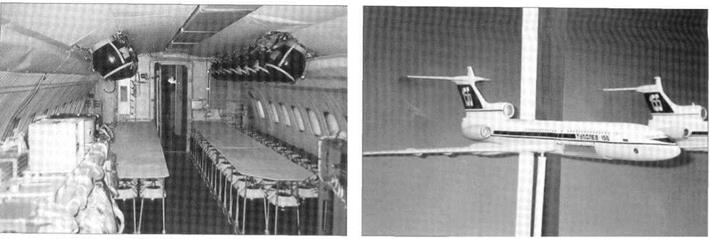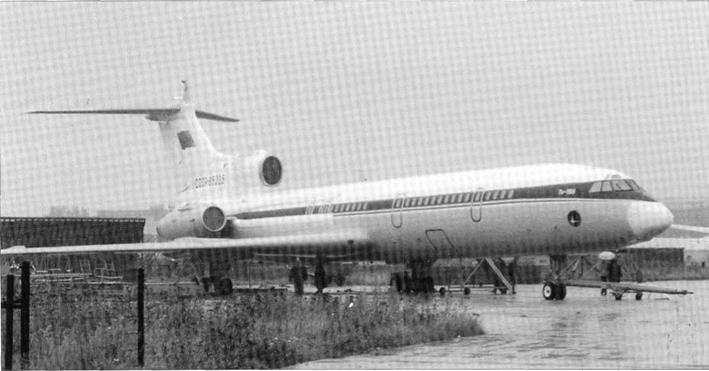Tupolev Tu-16 Experimental Versions
 |
Purpose: To use Tu-16 aircraft for various experimental purposes, and to take the basic design further.
Design Bureau: OKB-156 ofA N Tupolev, Moscow.
This graceful twin-jet bomber sustained what was in financial terms the most important programme in the entire history of the Tupolev design bureau up to that time. Since then, because of inflation, the Tu-154 and Tu-22/Tu-22M have rivalled it, though they were produced in smaller numbers. The prototype Tu-16, the Type 88, was a marriage of upgraded B-29 technology in structures, systems and to some degree in avionics, with totally new swept-wing aerodynamics and what were in the early 1950s super-power turbojet engines. The Tu-16 entered production in 1953 powered by Zubets (Mikulin KB) RD-3M engines of 8,200kg (18,078 Ib) thrust. The second series block had the RD-3M-200 of8,700kg (19,180 Ib) followed by the 9,500kg (20,944 Ib) RD-3M-500, which was then retrofitted to most earlier aircraft.
From 1953 the basic aircraft was repeatedly examined against alternatives based as far as possible on the same airframe but using different propulsion systems. Most of the studies had four engines. Tupolev had originally schemed the 88 around two Lyul’ka AL-5 turbojets, but the design grew in weight to match the big AM-3 engine, and this was the key to its win over the smaller Ilyushin with the Lyul’ka engines. In parallel with the
production aircraft one project team led by Dmitri S Markov studied versions of the 88 with not two but four AL-5 engines, and then four of the more powerful (typically 14,330 Ib, 6,500kg) AL-7 engines. These Type 90s would have been excellent bombers, with increased power and much better engine-out performance, but the decision was taken not to disrupt production. On the other hand, virtually the same inboard wing and engine installation was then used in the Tu-110 transport, two of which were built using the Tu-104 as a basis. Some of the four-engined bomber studies had engines in external nacelles hung on underwing pylons.
From 1954 Type 88 prototypes and a wide range of production Tu-16s were used over a period exceeding 40 years as experimental aircraft. Some carried out pioneer trials in aerial refuelling at jet speeds.
One large group of about 20 aircraft was kept busy in the development of avionics, including navigation, bombing and cartographic guidance, parent control of drones and targets, and the direction of self-defence gunnery systems.
Probably the most important single duty of Tu-16LL (flying laboratory) aircraft was to air – test new types of turboj et and turbofan engine. In each case the engine on test would be mounted in a nacelle either carried inside the weapon bay or, more often, recessed into it. Usually the test engine would be suspended on vertical hydraulic jacks or a large pivoted beam so that in flight it could be extended
down fully into the airstream, with its efflux well clear of the rear fuselage. In many cases the engine pod or the Tu-16 fuselage ahead of it would be fitted with a fairing or door which could be left behind or opened as the pod was extended for test. Among the engines air-tested under Tu-16LL aircraft were: the Ivchenko (later Progress) AI-25, Lyul’ka AL-7F – 1, AL-7F-2, AL-7F-4 and AL-31F, Solov’yov (Avi – advigatel) D-30, D-30K, D-30KP and D-30F6 (in MiG-31 installation), Lotarev (Ivchenko Progress) D-36, Kuznetsov NK-6 (with and without afterburner) and NK-8-2, Tumanskii (Soyuz)R-l 1 AF-300( Yak-28nacelle)andR-15- 300 (in the Ye-150 and the totally different MiG – 25installation), MetskhvarishviliR-2I-300and R-21F with Ye-8 inlet, Khachaturov R-27 versions (including the vectored R-27V-300 in a complete Yak-36M prototype fuselage, Mikulin (Soyuz) RD-3M (many versions), Kolesov (RKBM) RD-36-41 and RD-36-51, and Dobrynin (RKBM) VD-7, VD-7M and VD-19 (in a proposed Tu-128 installation), etc.
One Tu-16 had its entire nose replaced by that intended for the Myasishchev M-55, in order to test the comprehensive suite of sensors. Another tested a scaled version of the bogie main landing gear for the Myasishchev M-4 and 3M strategic bombers, replacing the normal nose landing gear. A new twin-wheel truck was added at the tail. According to documents a Tu-16 with outer wings removed tested the complete powerplant of the Yak-38 (presumably in free hovering flight) though photographs have not been discovered.
Purpose: To investigate the use of cryogenic fuels.
Design Bureau: ANTKA N Tupolev,
Moscow. Technical Director Valery Solozobov, cryogenic fuels ChiefDesigner Vladimir Andreyev.
For many years the USSR and its successor states have been replacing petroleum by natural gas, which in 1999 provides over 53 per cent of the total of all Russia’s energy supplies. Since 1982 what is today ANTK Tupolev has been investigating the use of natural gas and also hydrogen as fuels for aircraft, because of their availability and clean burning qualities. However, for use in vehicles both have to be liquefied by being cooled to exceedingly low temperatures. Liquid hydrogen (LH2) boils at -255°C, an unimaginably low temperature at which (for example) all conventional lubricating oils are rock-solid. Moreover, this fuel is very expensive, and hazardous from the viewpoints of detonation and fire. On the other hand, liquefied natural gas (LNG) is widely available, at least threefold cheaper in Russia than aviation kerosenes, and also significantly improves flight performance. It is straightforward to store and han-
Below: Tu-155.
Photographs on the following page:
die, and less fire/explosion hazardous even than today’s kerosenes. After years of laboratory work an existing civil transport was selected for use as an LNG flight test-bed. It has been flying since 1988. All work is now directed at the Tu-156, the first LNG aircraft designed to go into service.
T o flight-test an LNG sy stemANTKTupolev bailed back a Tu-154, No 85035, and replaced the No 3 (starboard) engine with an NK-88, fed with LNG by a completely separate fuel system. The NK-88 is a derivative of the Kuznetsov NK-8-2 turbofan (still fitted in the Nos 1 and 2 positions), with thrust unchanged at 20,945 Ib (9,500kg). The successor to Kuznetsov’s bureau is Samara/Trud. The complex feed system is shown in a drawing. The main tank, of 10ft 2in (3.1m) diameter and 17ft 81/2in (5.4m) long, is of AMG6 aluminium alloy, with a 50mm (2in) lagging of foamed polyurethane. The NK-88 engine has a dedicated two-stage centrifugal pump driven by a bleed-air turbine. LNG comes in at -152°C and is passed through a heat ex
changer to convert it to gas. The engine combustion chamber is able to accept either this supply of NG or, on command, to switch to the kerosene supply normally used for the other engines. Work is still underway on a low-emissions chamber which will be used on the improved NK-89 engine to be fitted to the Tu-156. The definitive Tu-156 is expected to have the fuel in giant saddle tanks along the top of the fuselage. Instead, to reduce time and cost, at least the first Tu-156 has a main tank (capacity 28,6601b, 13 tonnes) behind the passenger cabin and, to preserve centre of gravity position, an auxiliary tank (8,377 Ib, 3,800kg) in the forward underfloor baggage hold. This reduces payload from 18 tonnes to 14 (30,864 Ib). Range will be 1,616 miles (2,600km) on LNG only, or 2,051 miles (3,300km) on combined LNG and kerosene.


![]()
 Eventually the Earth’s store of petroleum will run dry. It is pointless to say ‘More keeps being discovered’. The world’s aircraft will then have no alternative but to switch to another fuel, and LNG is the obvious choice.
Eventually the Earth’s store of petroleum will run dry. It is pointless to say ‘More keeps being discovered’. The world’s aircraft will then have no alternative but to switch to another fuel, and LNG is the obvious choice.
|












